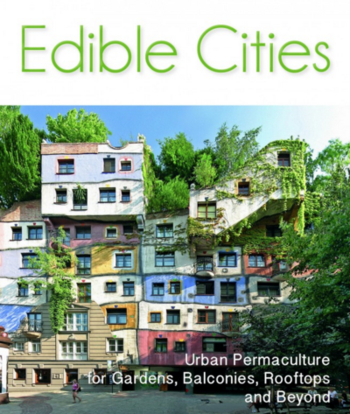





 1
1




The intention of this book is to inspire readers to spot existing wasted spaces in their cities and make intelligent use of them... In Edible Cities we want to show how people have discovered new solutions and explored fresh territory in response to difficult circumstances. This is with few resources, without state subsidies and without government aid. Many of these solutions could be initially ridiculed as isolated cases, but we can see each one as a nucleus, demonstrating and inspiring alternative solutions
“It’s clear that real change can only start in ourselves, with a return to a healthy lifestyle. The demand for such a change, to a life closer to nature and in harmony with our surroundings, is there. It’s time to make that change. Only then can our dream of a different world become reality. Urban gardening is a way of showing the 99% of people, what this new culture might look like.”
How permies.com works
What is a Mother Tree ?
 1
1




Burra Maluca wrote:Edible Cities by Judith Anger, Immo Fiebrig and Martin Schnyder
I give this book 9 out of 10 acorns
If I were to describe this book in one word, it would be - inspiring
And if were to use three words, they would be - inspired by Sepp
The three authors met in 2010 at the third Permaculture in Practice course on Sepp Holzer's Krameterhof farm. The one year training programme had a profound impact on them and they wanted to do something to make a difference to the world, so they came together to write a book to inspire city dwellers to find ways to make meaningful changes in their lives. Whilst it includes all the basics you need to understand what permaculture is, its history, and how it differs from organic agriculture, where it really shines is in the wide range of totally inspiring examples it provides, from all over the world.
I recently read Permaculture in Pots by Juliet Kemp and I think the two books complement each other very well. While Juliet's book starts off focusing in very close and then working out, Edible Cities is much more 'top-down' in its outlook, and has a very cosmopolitan approach.
In its own wordsThe intention of this book is to inspire readers to spot existing wasted spaces in their cities and make intelligent use of them... In Edible Cities we want to show how people have discovered new solutions and explored fresh territory in response to difficult circumstances. This is with few resources, without state subsidies and without government aid. Many of these solutions could be initially ridiculed as isolated cases, but we can see each one as a nucleus, demonstrating and inspiring alternative solutions
The first inspiration is a two page article about a luxury hotel set on a volcanic island off the coast of Brazil. Rather than have fresh produce flown in they set up an orchard and hydroponic beds, which form a salad bar around the restaurant's terrace. The second inspiration, again with two pages, returns to Vienna to look at the work of Friedensreich Regentag Dunkelbunt Hundertwasser, an architect who believes that when a new building is raised then "the area taken away from nature should be returned once construction is complete, by planting on the roof or in other parts of the building." The cover of the book sports a photograph of one of his rather enchanting creations. And then to a French chateau with Baroque style geometric gardens which grow polycultures of vegetables that are harvested to stop the fruit weighing the plants down, and then given away to visitors.
The range of projects rather blew me away. The book went on to describe vegetable orchestras and the history of guerrilla gardening and then stepped back a while to let me absorb all those ideas while it tried to get me back down to earth with a chapter designed to encourage us all to actually become gardeners, with thoughts on self-sufficiency, waste, materials, legalities, allotments, community gardens, pick-your-own and community supported agriculture.
By this point I was feeling rather stretched out, with my head still in the clouds but my feet planted firmly back on the ground. The next chapter, which forms the bulk of the book, took every opportunity to fill me with more examples, each rounded off with practical permaculture tips. So I learned about how Sepp uses garbage tower planters to feed the poor and homeless in Columbia, Brazil and Thailand, how Todmorden in the UK became an edible town, and then, just when I'd gotten used to my head being dragged all over the world, I found myself reading an interview about the occupy movement by my friend and neighbour, Dennis Posthumus, rounded off with a page about using old shopping trolleys as planters.
There are plenty more projects to inspire you too, from chilli peppers in the ganglands of Mexico to making raised beds out of used tyres in Detroit. Also, my personal favourite, Palaver Under the Apple Tree. This is a project in Eastern Austria in which around twenty German speaking families and individuals, from Kurdistan, Bosnia, the Americas, Africa, Nepal, Austria and Germany cultivate the fruits and vegetables common to their homes. The whole project is designed to promote communication, with garden beds laid out like the veins on a leaf with no formal boundaries between the area allotted to each member.
The book is rounded off with a chapter about plants and compost, and finally a helpful section with contacts and resources, suggestions for further reading and an open letter by Sepp Holzer to encourage land reform, ensuring that every citizen of earth has access to land.
But I'm going to give the last word to a quote from the book by Dennis, who I visited recently at his project in Vale da Sarvinda
“It’s clear that real change can only start in ourselves, with a return to a healthy lifestyle. The demand for such a change, to a life closer to nature and in harmony with our surroundings, is there. It’s time to make that change. Only then can our dream of a different world become reality. Urban gardening is a way of showing the 99% of people, what this new culture might look like.”
And this book will help you do just that.
Community Building 2.0: ask me about drL, the rotational-mob-grazing format for human interactions.




 I find this book inspiring and encouraging, but my lower score for this book is due to a fact that I find this book quite chaotic and when it comes to describing practical techniques, not clear enough in some cases (as it always is for me in Sepp Holzer's and his followers publications). It seems that some things are so obvious for Sepp and his students that they do not bother to go into details. My impression is that the authors were trying to cover too many topics in a small volume book, my personal preference is to read more focused and detailed publications.
I find this book inspiring and encouraging, but my lower score for this book is due to a fact that I find this book quite chaotic and when it comes to describing practical techniques, not clear enough in some cases (as it always is for me in Sepp Holzer's and his followers publications). It seems that some things are so obvious for Sepp and his students that they do not bother to go into details. My impression is that the authors were trying to cover too many topics in a small volume book, my personal preference is to read more focused and detailed publications.Gert in the making
 1
1




![Filename: 7acorns.png
Description: [Thumbnail for 7acorns.png]](/t/44358/a/34292/7acorns.png)
Outdoor and Ecological articles (sporadic Mondays) at http://blog.dxlogan.com/ and my main site is found at http://www.dxlogan.com/









